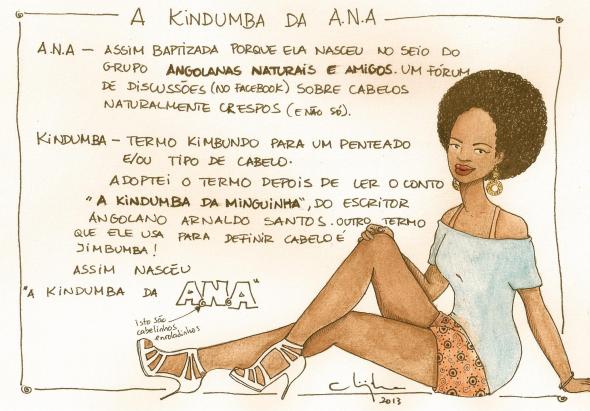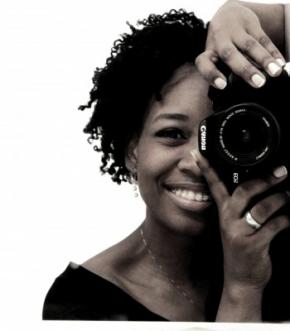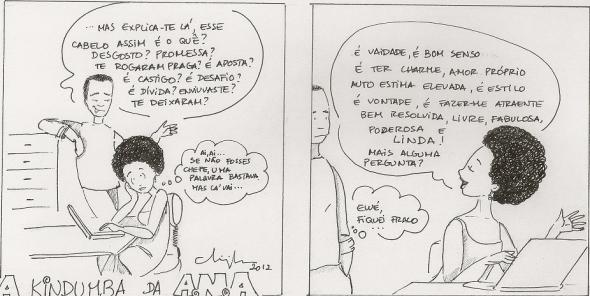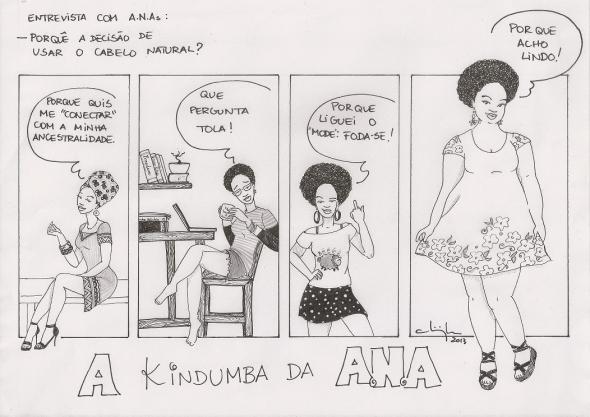‘People That Look Like Themselves': A Comic that Celebrates Natural Black Hair
 Image that explains the origin of the name “A Kindumba da ANA” on her page on Facebook. ANA - Baptized this way because she was born at the breast of the group Angolanas Naturais e Amigos, a forum (on Facebook) of discussion about naturally curly hair (and not just that). Kindumba- Kimbundo is a term for a hairstyle and/or a kind of hair. I adopted the term after reading the story A kindumba da minguinha, by the Angolan writer Arnaldo Santos. Another term that he uses to define hair is Jimbumba! That's how “A Kindumba da ANA” was born. (And Chiquinha, the author, drew some little curly hairs in the word ANA)
Image that explains the origin of the name “A Kindumba da ANA” on her page on Facebook. ANA - Baptized this way because she was born at the breast of the group Angolanas Naturais e Amigos, a forum (on Facebook) of discussion about naturally curly hair (and not just that). Kindumba- Kimbundo is a term for a hairstyle and/or a kind of hair. I adopted the term after reading the story A kindumba da minguinha, by the Angolan writer Arnaldo Santos. Another term that he uses to define hair is Jimbumba! That's how “A Kindumba da ANA” was born. (And Chiquinha, the author, drew some little curly hairs in the word ANA)
[All links lead to Portuguese-language pages except when otherwise noted.]
Francisca Nzenze Meireles, also known as Chiquinha, is the author of “A Kindumba da ANA,” a comic that uses humor to promote the beauty of natural hair and naturally curly hair. She is Angolan and has lived in Brazil for a few years. The name ANA refers to the initials of Angolanas Naturais e Amigos (Natural Angolan Women and Friends), an online forum. The strips can be seen on Chiquinha’s page. Francisca Nzenze Meireles, also known as Chiquinha - “On the street, I see it emerging bit by bit, another norm of people. People that look like themselves.” Photo used with permission.During the week in which Brazil celebrates Black Awareness Day [en], learn a little more about this artist, her impressions of working between different cultures, and about the affirmation of one’s identity. And, in the spirit of the Portuguese language, take the opportunity to learn a little more about the accent and culture of Angola.
Francisca Nzenze Meireles, also known as Chiquinha - “On the street, I see it emerging bit by bit, another norm of people. People that look like themselves.” Photo used with permission.During the week in which Brazil celebrates Black Awareness Day [en], learn a little more about this artist, her impressions of working between different cultures, and about the affirmation of one’s identity. And, in the spirit of the Portuguese language, take the opportunity to learn a little more about the accent and culture of Angola.
Global Voices (GV): Talk a little bit about the setting of comics in Angola. What have you read and what do you currently read? Which ones do you recommend?
Chiquinha (CH): I was a regular reader of one of the little Angolan strips from the 90s – MANKIKO [en, pt] by Sérgio Piçarra, an Angolan cartoonist. It was very good, but it doesn’t exist anymore. As a matter of fact, the book market in Angola is not very active. I don’t know what is being produced right now. I was invited to participate in a comic exposition in Angola promoted by OLINDOMAR studios. I sent some work, but I’m not even sure if it was shown. They never contacted me again. But I imagine that the “banda desenhada”, as comics are called in Angola, are “alive and well.” There are many talented youth there! The problems are with the editors.
GV: Your work began in Angola and now continues in Brazil. Has this changed in some way the day-to-day inspiration for your work?
CH: In Angola, I have a children’s book that I wrote and illustrated, but I haven’t done anything that is similar to comic illustration. The “A Kindumba da ANA” comics began here in Brazil (where I live today) when I became interested in natural hair, as well as the curiosity and love for naturally curly hair. It was almost by chance that “A Kindumba da ANA” was born. I participated in a Facebook group called Angolanas Naturais e Amigos [Natural Angolan Women and Friends], and in the group there was a lot of discussion about natural hair.
In the discussion with other girls, there were always stories of day-to-day life that were funny, boring, controversial, sad, happy… anyway, as I really like to draw, I decided to show recognition for some of the girls with little stories that would have a happy or funny ending. And that’s how “A Kindumba da ANA” was born.
The fact that I’m in Brazil hasn’t changed anything because the source of inspiration has continued to be naturally curly hair, and nothing more. Some episodes refer specifically to Brazil, but always with hair as the main character.![In this strip, Ana is questioned about the time dedicated to her hair and her pity for those who straighten their kindumba (curly hair). I have concluded that now, with naturally curly hair, it's just me that styles it.” (1) Ana, don't you waste a lot of time and patience on your hair? (2) No way! Before it was - (3) Wait for my stylist - (4) Hope that she was in a good mood; (5) That she didn't pull on my hair with force; (6) And that she didn't burn me... [Ana says (worried) - Careful with my ear. And the stylist responds, impatiently - I know what I'm doing!] (7) Now - it's just me. (8) Whenever I want! (9) And I discovered that my hair is growing!!!” In this strip, Ana is questioned about the time dedicated to her hair and her pity for those who straighten their kindumba (curly hair). I have concluded that now, with naturally curly hair, it's just me that styles it.” (1) Ana, don't you waste a lot of time and patience on your hair? (2) No way! Before it was - (3) Wait for my stylist - (4) Hope that she was in a good mood; (5) That she didn't pull on my hair with force; (6) And that she didn't burn me... [Ana says (worried) - Careful with my ear. And the stylist responds, impatiently - I know what I'm doing!] (7) Now - it's just me. (8) Whenever I want! (9) And I discovered that my hair is growing!!!”](https://www.buala.org/sites/default/files/imagecache/full/2013/12/escanear-462.jpg) In this strip, Ana is questioned about the time dedicated to her hair and her pity for those who straighten their kindumba (curly hair). I have concluded that now, with naturally curly hair, it's just me that styles it.” (1) Ana, don't you waste a lot of time and patience on your hair? (2) No way! Before it was - (3) Wait for my stylist - (4) Hope that she was in a good mood; (5) That she didn't pull on my hair with force; (6) And that she didn't burn me… [Ana says (worried) - Careful with my ear. And the stylist responds, impatiently - I know what I'm doing!] (7) Now - it's just me. (8) Whenever I want! (9) And I discovered that my hair is growing!!!”
In this strip, Ana is questioned about the time dedicated to her hair and her pity for those who straighten their kindumba (curly hair). I have concluded that now, with naturally curly hair, it's just me that styles it.” (1) Ana, don't you waste a lot of time and patience on your hair? (2) No way! Before it was - (3) Wait for my stylist - (4) Hope that she was in a good mood; (5) That she didn't pull on my hair with force; (6) And that she didn't burn me… [Ana says (worried) - Careful with my ear. And the stylist responds, impatiently - I know what I'm doing!] (7) Now - it's just me. (8) Whenever I want! (9) And I discovered that my hair is growing!!!”
GV: How is it to work between different cultures?
CH: I don’t consider Brazil that different from Angola, culturally speaking. By the way, Angola currently consumes a lot of global culture. Mostly younger people. Not even the differences in language are an obstacle to the understanding of my comics. Even so, most of the fans of “Kindumba da ANA” are Brazilian. I don’t know if it’s because the Internet is more accessible here in Brazil, or if there are other reasons for this.
GV: In Brazilian comics, the possibilities of the online world and the increase in participation of authors from other corners of the country seem to bringing a greater diversity to the field, with the inclusion of other themes and world views in the comics that are available to readers. From your point of view as a foreigner, do you believe this is a trend? How was your reception?
CH: I am not familiar with very many Brazilian comics. I know Turma da Mônica, the cartoons of Laerte, Henfil… but I’m not a regular reader of the little magazines of comics. Therefore, I wouldn’t know how to respond if there is a trend of change and inclusion of new themes.
About my reception, I must say that the response has been rather positive. People like to see themselves represented. I try to give to ANA a light and pleasant personality that allows children and adults to think of their natural hair simply as what it is: naural hair. ANA is meant to make a theme that could easily be overwhelmed by controversy a bit lighter. In this strip, Ana suffers from harassment from her boss with respect to her hair. (1) The boss says - Explain to me, with your hair like that, why is it? Some problem? A pledge? Somebody put a curse on you? Is it a bet? Is it punishment? A challenge? A debt? Were you widowed? Did someone leave you? (2) Ana thinks - If you weren't the boss, one word would do it, but that's how it is… (3) Ana responds - It's pride, it's good sense, it's having charm, self-love, higher self-esteem, it's stylish, it's a choice, it's making myself attractive, well-resolved, free, fabulous, powerful and beautiful! Any more questions? (4) The boss thinks - Uh-oh, now I look weak…
In this strip, Ana suffers from harassment from her boss with respect to her hair. (1) The boss says - Explain to me, with your hair like that, why is it? Some problem? A pledge? Somebody put a curse on you? Is it a bet? Is it punishment? A challenge? A debt? Were you widowed? Did someone leave you? (2) Ana thinks - If you weren't the boss, one word would do it, but that's how it is… (3) Ana responds - It's pride, it's good sense, it's having charm, self-love, higher self-esteem, it's stylish, it's a choice, it's making myself attractive, well-resolved, free, fabulous, powerful and beautiful! Any more questions? (4) The boss thinks - Uh-oh, now I look weak…
GV: We live in a time of affirmation of all identities– ethnicity, gender, religion, and others. The demonstration of these identities is rather perceptible online, and one of these examples is your own work with “A Kindumba da Ana”. Do you think that this change will manage to jump from the virtual world onto the streets.
I think so, and I must say that social networks allow this to happen in a rather comprehensive way. I myself have returned to wearing my hair naturally after researching on YouTube what to do with my hair, because I really didn’t know how to take care of it. I didn’t know how to wear it, comb it, stye it, wash it… After that I went to Facebook, exchanged experiences, and made contact with other people just like me, and every day I feel more encouraged to pursue this new version of myself, one that isn’t seen on television, in magazines, or in literature.
On the street, I see it emerging bit by bit, another norm for people. People that look like themselves. People that don’t want to look like the standardized norm of a pre-fabricated society! (1) Why the decision to wear your hair naturally? (2) Ana, dressed in African clothing, says - Because I wanted to “connect” with my ancestry. (3) Ana, with glasses, sitting at a desk, with a cup of coffee in hand. She says - What a silly question! (4) Ana in a short skirt, blouse, big earrings, giving the middle finger with a mischievous smile. She says - Because I told “fashion” to screw yourself! (5) Ana in a flowered dress and a candid smile. She says - Because I think its beautiful!
(1) Why the decision to wear your hair naturally? (2) Ana, dressed in African clothing, says - Because I wanted to “connect” with my ancestry. (3) Ana, with glasses, sitting at a desk, with a cup of coffee in hand. She says - What a silly question! (4) Ana in a short skirt, blouse, big earrings, giving the middle finger with a mischievous smile. She says - Because I told “fashion” to screw yourself! (5) Ana in a flowered dress and a candid smile. She says - Because I think its beautiful!
This article is part of the a series that celebrates Black Awareness Day in Brazil (November 20). Read the first interview: Persistent Stereotypes, Latent Prejudices: Black Characters in Brazilian Comics.
source: http://globalvoicesonline.org/2013/11/24/angola-brazil-comics-natural-black-hair/